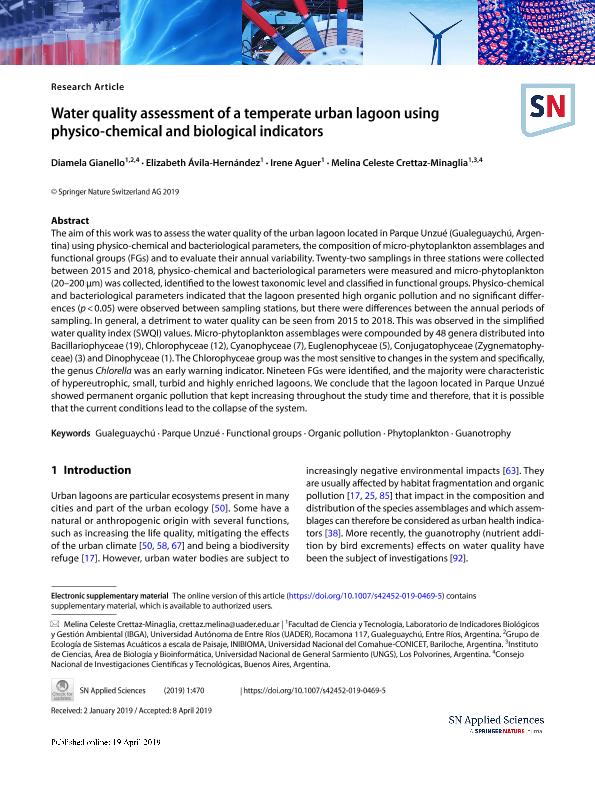Mostrar el registro sencillo del ítem
dc.contributor.author
Gianello, Diamela

dc.contributor.author
Ávila Hernández, Elizabeth
dc.contributor.author
Aguer, Irene

dc.contributor.author
Crettaz Minaglia, Melina Celeste

dc.date.available
2021-01-11T21:47:33Z
dc.date.issued
2019-04
dc.identifier.citation
Gianello, Diamela; Ávila Hernández, Elizabeth; Aguer, Irene; Crettaz Minaglia, Melina Celeste; Water quality assessment of a temperate urban lagoon using physico-chemical and biological indicators; Springer; SN Applied Sciences; 1; 5; 4-2019; 1-13
dc.identifier.issn
2523-3971
dc.identifier.uri
http://hdl.handle.net/11336/122437
dc.description.abstract
The aim of this work was to assess the water quality of the urban lagoon located in Parque Unzué (Gualeguaychú, Argentina) using physico-chemical and bacteriological parameters, the composition of micro-phytoplankton assemblages and functional groups (FGs) and to evaluate their annual variability. Twenty-two samplings in three stations were collected between 2015 and 2018, physico-chemical and bacteriological parameters were measured and micro-phytoplankton (20–200 µm) was collected, identified to the lowest taxonomic level and classified in functional groups. Physico-chemical and bacteriological parameters indicated that the lagoon presented high organic pollution and no significant differences (p < 0.05) were observed between sampling stations, but there were differences between the annual periods of sampling. In general, a detriment to water quality can be seen from 2015 to 2018. This was observed in the simplified water quality index (SWQI) values. Micro-phytoplankton assemblages were compounded by 48 genera distributed into Bacillariophyceae (19), Chlorophyceae (12), Cyanophyceae (7), Euglenophyceae (5), Conjugatophyceae (Zygnematophyceae) (3) and Dinophyceae (1). The Chlorophyceae group was the most sensitive to changes in the system and specifically, the genus Chlorella was an early warning indicator. Nineteen FGs were identified, and the majority were characteristic of hypereutrophic, small, turbid and highly enriched lagoons. We conclude that the lagoon located in Parque Unzué showed permanent organic pollution that kept increasing throughout the study time and therefore, that it is possible that the current conditions lead to the collapse of the system.
dc.format
application/pdf
dc.language.iso
eng
dc.publisher
Springer

dc.rights
info:eu-repo/semantics/openAccess
dc.rights.uri
https://creativecommons.org/licenses/by-nc-sa/2.5/ar/
dc.subject
Gualeguaychú
dc.subject
Parque Unzué
dc.subject
Functional groups
dc.subject
Organic pollution
dc.subject
Phytoplankton
dc.subject
Guanotrophy
dc.subject.classification
Ecología

dc.subject.classification
Ciencias Biológicas

dc.subject.classification
CIENCIAS NATURALES Y EXACTAS

dc.title
Water quality assessment of a temperate urban lagoon using physico-chemical and biological indicators
dc.type
info:eu-repo/semantics/article
dc.type
info:ar-repo/semantics/artículo
dc.type
info:eu-repo/semantics/publishedVersion
dc.date.updated
2020-11-20T14:42:06Z
dc.journal.volume
1
dc.journal.number
5
dc.journal.pagination
1-13
dc.journal.pais
Suiza

dc.journal.ciudad
Basilea
dc.description.fil
Fil: Gianello, Diamela. Consejo Nacional de Investigaciones Científicas y Técnicas. Centro Científico Tecnológico Conicet - Patagonia Norte. Instituto de Investigaciones en Biodiversidad y Medioambiente. Universidad Nacional del Comahue. Centro Regional Universidad Bariloche. Instituto de Investigaciones en Biodiversidad y Medioambiente; Argentina. Universidad Autónoma de Entre Ríos. Facultad de Ciencia y Tecnología; Argentina
dc.description.fil
Fil: Ávila Hernández, Elizabeth. Universidad Autónoma de Entre Ríos. Facultad de Ciencia y Tecnología; Argentina
dc.description.fil
Fil: Aguer, Irene. Universidad Autónoma de Entre Ríos. Facultad de Ciencia y Tecnología; Argentina
dc.description.fil
Fil: Crettaz Minaglia, Melina Celeste. Consejo Nacional de Investigaciones Científicas y Técnicas; Argentina. Universidad Nacional de General Sarmiento. Instituto de Ciencias. Área de Biología y Bioinformática; Argentina. Universidad Autónoma de Entre Ríos. Facultad de Ciencia y Tecnología; Argentina
dc.journal.title
SN Applied Sciences
dc.relation.alternativeid
info:eu-repo/semantics/altIdentifier/url/https://link.springer.com/article/10.1007%2Fs42452-019-0469-5
dc.relation.alternativeid
info:eu-repo/semantics/altIdentifier/doi/https://doi.org/10.1007/s42452-019-0469-5
Archivos asociados
